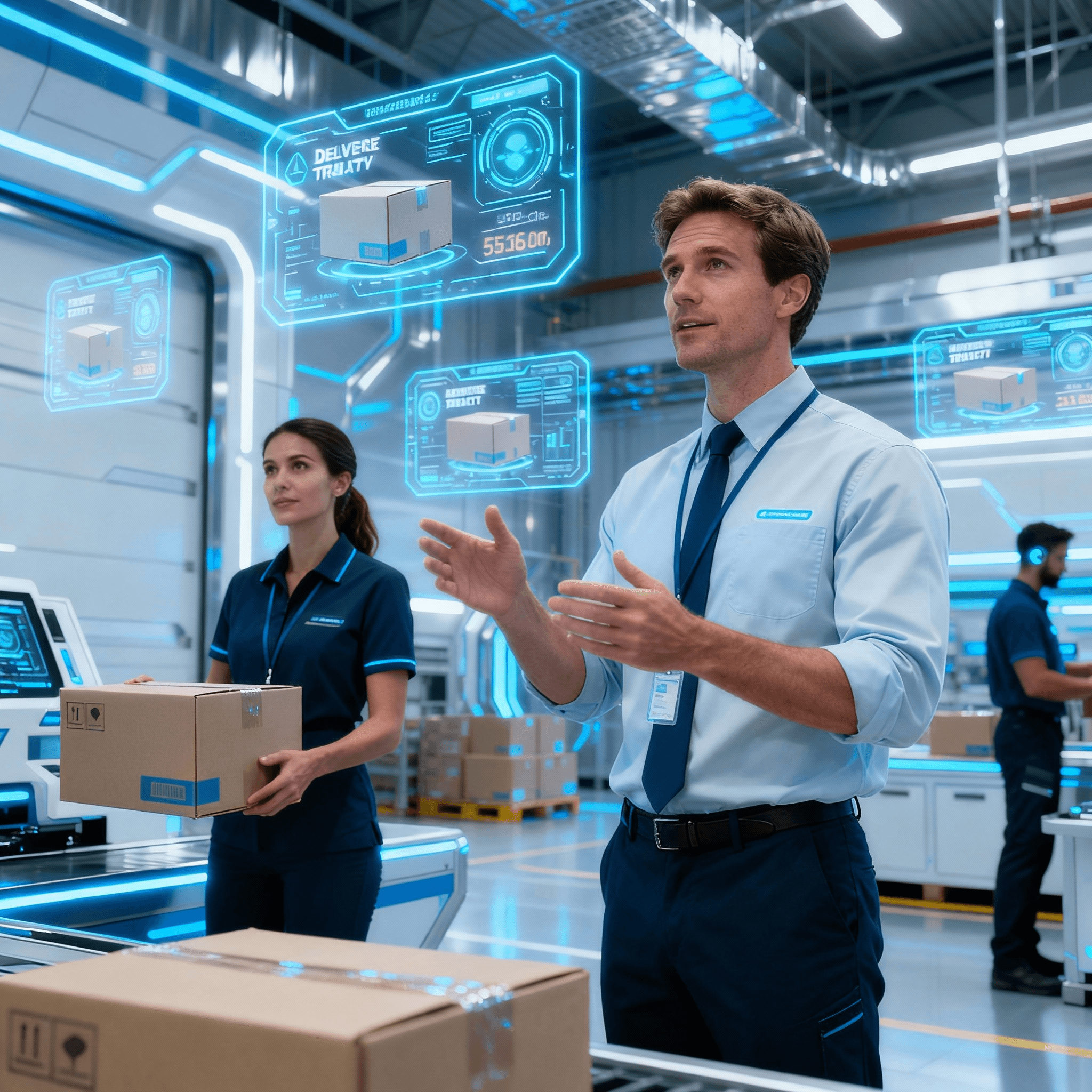AI-Powered Tracking: The Future of Delivery Transparency in Logistics
Wednesday, 8 Oct 2025
|
The Future of Delivery Transparency: AI-Powered Tracking Solutions That Actually Work
In the competitive world of logistics, customer expectations are higher than ever. Consumers demand real-time information about their orders, and logistics companies face increasing pressure to deliver transparency and reliability throughout the shipping process. Traditional tracking systems, while effective, are often limited in their ability to provide up-to-the-minute, actionable data, leaving both customers and logistics teams guessing about the exact location and status of a shipment.
The future of delivery transparency is here, and it’s powered by Artificial Intelligence (AI). AI-driven tracking solutions are revolutionizing how logistics companies manage and communicate about shipments, making real-time updates not only possible but reliable and insightful. For logistics executives—CEOs, CXOs, and COOs—understanding how these AI-powered tracking solutions work and the potential benefits they offer is essential for staying competitive and enhancing customer satisfaction.
In this article, we will explore how AI-powered tracking solutions are transforming delivery transparency and how logistics companies can leverage these innovations to meet the evolving demands of their customers.
The Evolution of Shipment Tracking: From Static Updates to Real-Time Transparency
Historically, shipment tracking in logistics has been limited to basic milestones: when a package is shipped, when it's out for delivery, and when it's been delivered. Customers could only access information once these events occurred, creating uncertainty and a lack of control.
With the rise of e-commerce and the increasing expectations for faster deliveries, traditional tracking systems are no longer sufficient. Customers demand immediate, accurate, and comprehensive visibility into their shipments, including the ability to monitor progress in real-time.
How Traditional Shipment Tracking Falls Short:
- Static Updates: Customers receive updates only after a significant event happens, often leading to frustration when delays or changes occur.
- Limited Visibility: Traditional systems often fail to provide granular details, leaving customers wondering about the exact status of their packages.
- Lack of Predictive Insights: If a delay or disruption happens, traditional tracking systems don’t offer a proactive solution or provide predictive insights on when the issue will be resolved.
AI-powered tracking solutions solve these issues by offering real-time, actionable insights, giving both logistics companies and customers full visibility and control over the delivery process.
How AI-Powered Tracking Solutions Work: A Deep Dive
AI-powered tracking goes beyond basic location updates. By integrating AI, machine learning, and real-time data from multiple sources, these systems offer unparalleled transparency and control throughout the entire delivery lifecycle. Here's how it works:
1. Real-Time Location Data and Predictive Analytics
AI systems leverage real-time GPS data and machine learning algorithms to predict the most efficient routes and give continuous updates about the shipment’s exact location. By analyzing data from traffic patterns, weather conditions, and historical delivery data, AI can predict not only where the package is but also when it will arrive and whether there are potential disruptions along the way.
How It Helps:
- Accurate Delivery Windows: AI can predict precise delivery times, providing customers with a more reliable estimate.
- Fewer Surprises: If a delay is anticipated, AI systems can adjust delivery windows and notify the customer in advance, reducing the common “where’s my package?” inquiry.
Real-World Example:
UPS has been using AI in its ORION (On-Road Integrated Optimization and Navigation) system to optimize delivery routes and offer more accurate delivery time predictions. With AI, UPS can predict traffic conditions, reroute delivery vehicles in real time, and provide customers with more precise delivery windows.
2. Enhanced Customer Communication with Automated Updates
AI not only tracks shipments but also communicates updates in real-time. By using automated messaging systems and chatbots, AI can proactively alert customers about the status of their packages, including any potential delays or changes in the delivery schedule.
How It Helps:
- Instant Notifications: Customers receive immediate updates about their package’s status, reducing uncertainty.
- 24/7 Availability: AI-driven chatbots can provide real-time answers to customers' inquiries, even outside of business hours, ensuring constant support.
Real-World Example:
FedEx uses AI to power its customer service chatbots, providing real-time updates on shipments and answering common questions about delivery schedules. By leveraging AI for communication, FedEx has improved customer engagement and satisfaction.
3. AI-Driven Risk Management and Exception Handling
AI-powered tracking systems are designed to anticipate potential issues before they occur. By monitoring real-time data from various sources, such as weather forecasts, traffic patterns, and route disruptions, AI can identify risks and proactively address them.
How It Helps:
- Proactive Problem Solving: If a shipment is at risk of being delayed due to weather or traffic, AI can automatically adjust the route or offer alternative solutions.
- Increased Reliability: By identifying potential risks early, AI can help logistics companies prevent delays and provide accurate delivery windows, building trust with customers.
Real-World Example:
Maersk, a global shipping leader, uses AI to predict potential disruptions in the supply chain, such as port congestion or extreme weather. This proactive approach allows Maersk to make adjustments before problems escalate, ensuring that shipments reach their destination on time.
4. End-to-End Visibility Across the Supply Chain
AI-powered tracking systems don’t just track the final leg of the delivery—they provide end-to-end visibility from the warehouse to the customer’s doorstep. By integrating data from various points in the supply chain, AI can provide real-time tracking from inventory management, packaging, and shipping to final delivery.
How It Helps:
- Full Transparency: Customers can track their shipments from start to finish, gaining confidence in the process and reducing the need for frequent inquiries.
- Improved Operations: Logistics companies gain a clearer picture of the entire supply chain, enabling better decision-making and improved operational efficiency.
Real-World Example:
DHL has implemented a global tracking platform that uses AI to monitor the entire logistics process, from warehousing to the final delivery. This full visibility helps DHL streamline operations and provide customers with transparent, real-time updates.
The Business Impact of AI-Powered Tracking in Logistics
The integration of AI into shipment tracking offers several key business benefits for logistics companies, including:
1. Improved Customer Satisfaction
- Enhanced Communication: Real-time updates and proactive notifications keep customers informed and satisfied.
- Accurate Delivery Windows: Customers no longer need to ask “where’s my package?”—AI ensures they know exactly when to expect it.
2. Increased Operational Efficiency
- Optimized Routes: AI-powered route optimization reduces fuel costs, travel time, and inefficiencies, improving overall logistics performance.
- Predictive Problem-Solving: AI can predict and mitigate potential issues, preventing delays and optimizing resource allocation.
3. Cost Savings
- Reduced Customer Service Burden: By automating communication and problem-solving, AI reduces the need for manual customer service intervention, saving time and labor costs.
- Efficient Resource Allocation: AI’s predictive capabilities help companies better allocate resources, improving fleet utilization and reducing waste.
4. Competitive Advantage
- Better Customer Experience: Offering real-time transparency and proactive communication helps build loyalty and attract repeat customers.
- Differentiation: By adopting AI-powered tracking solutions, logistics companies can differentiate themselves in a crowded market, offering superior service compared to competitors.
Challenges and Considerations for AI-Powered Tracking Solutions
While AI-powered shipment tracking offers numerous benefits, logistics companies must consider the following challenges:
- Data Privacy and Security: Handling real-time tracking data requires robust security measures to protect customer information and prevent data breaches.
- Integration with Existing Systems: Integrating AI-powered tracking solutions with legacy systems may require significant investments in infrastructure and staff training.
- Regulatory Compliance: As AI in logistics becomes more prevalent, companies must stay compliant with regulations around data usage, transparency, and AI ethics.
Conclusion: The Future of Delivery Transparency is AI-Powered
AI-powered tracking solutions are set to transform the logistics industry, providing real-time visibility, predictive insights, and automated communication. For logistics executives, embracing these innovations is no longer optional—it’s essential for staying competitive in an increasingly customer-centric world. By offering unparalleled transparency and efficiency, AI can not only eliminate the common “Where’s my package?” question but also enhance operational efficiency, improve customer satisfaction, and deliver significant cost savings.
Next Steps: Book a Demo with Debales AI!
Ready to implement AI-powered tracking solutions and revolutionize your logistics operations? Book a demo with Debales AI today and discover how our AI-driven solutions can improve your shipment tracking and enhance customer satisfaction.
Suggested Posts:
For further insights into AI in logistics, check out these related articles:
All blog posts
View All →
Friday, 28 Nov 2025
The 90-Day Roadmap: Moving from Ad-Hoc AI to Operational Excellence
Stuck in AI experimentation? Learn how to escape Level 2 maturity using the Mess-O-Meter to diagnose chaos, prioritize with triangulation, and scale in 90 days.

Thursday, 27 Nov 2025
Mess-O-Meter Deep Dive: Real Logistics Examples for Digital Maturity
Discover Mess-O-Meter examples diagnosing digital chaos in logistics—baseline workflows, benchmark maturity, create AI roadmaps with real steps for transformation success.

Wednesday, 26 Nov 2025
Multi-Agent AI via Email: End-to-End Automation for Logistics Complexity
Explore agentic orchestration where autonomous email AI agents coordinate freight, customs, insurance, and carriers—automating multi-party processes for resilient supply chains.